"Summer Pasta"
May 21, 2009 -
Vol 1, Issue 7
| |
|
Updated
Website
|
If you haven't visited our website lately, take a
look. We are updating and expanding our site
daily. I think you will enjoy the changes.
|
E-Newsletter
Drawing
|
If you receive our newsletter, you will be
entered into a drawing each month for a great prize for
your kitchen. Check here each month to see if you
have won, if so, come in to collect your
prize!
April's
winner:
Tracy
Miller
Tracy won a magnetic notepad. Congrats
Tracy!
__________________ | |
|
Prime
Time for Pasta
|
Pasta! Who doesn't love pasta? Any season is the
perfect time for enjoying pasta, but the spring and
summer seasons offer renewed possibilities for
incorporating fresh ingredients 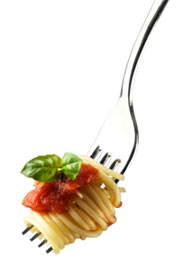 directly from the garden or
farmer's market - fresh herbs, sun-warmed tomatoes, and
a host of other possibilities. During this time of year,
pasta becomes a canvas for bright colors and tantalizing
tastes. Served hot, warm, or cold, pasta's versatility
matches summer's easy-going schedule. In this issue,
we'll encourage you to experiment with some new shapes
and sauces, train you on cooking perfect pasta, and
review some common foods that always seem to partner
well with a good pasta dish. We conclude with
three scrumptious, easy recipes for summertime pasta
that will rival your favorite restaurant's pasta entrees
for taste, appearance, and enjoyment! Buon
Appetito! directly from the garden or
farmer's market - fresh herbs, sun-warmed tomatoes, and
a host of other possibilities. During this time of year,
pasta becomes a canvas for bright colors and tantalizing
tastes. Served hot, warm, or cold, pasta's versatility
matches summer's easy-going schedule. In this issue,
we'll encourage you to experiment with some new shapes
and sauces, train you on cooking perfect pasta, and
review some common foods that always seem to partner
well with a good pasta dish. We conclude with
three scrumptious, easy recipes for summertime pasta
that will rival your favorite restaurant's pasta entrees
for taste, appearance, and enjoyment! Buon
Appetito!
|
Elko
Downtown Upcoming Events!
|
Elko
Downtown Business Association Upcoming
Events:
3rd
Thursdays Girls' Night Out Shopping Event
Thursday,
May 21st
Participating
Stores Open until 7pm
Game-themed
Shopping Savings at 11 Downtown Stores
2nd Annual Elko DBA Sidewalk
Sale
Saturday,
June 13th
Stores
open at 8am
Huge
Savings at 12 different stores!
3rd
Annual Elko DBA Wine Walk Dates
Saturday,
July 11th
Saturday,
August 8th
Saturday,
September 12th
|
Cucina
Fresca's Upcoming Events!
|
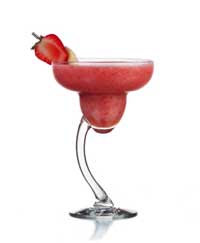
Join
Us!
Saturday, May
23rd:
To
kick off the summer entertaining season and to introduce
you to our "Thirsty
Tuesdays" promotion (in conjunction with Duncan
Little Creek Gallery Bar) join us for free samples of
cocktails made with our favorite cocktail mixing
company, Stirrings. |
Cucina
Fresca's Mother's Day
Drawing
|
|
Mother's Day Tea
Basket Drawing
Winner:
The winner of
our 6th Annual Mother's Day
Te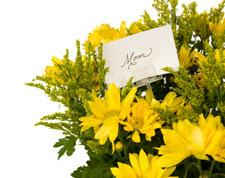 a Basket Drawing is . . . a Basket Drawing is . . .
Jenny
Hoerger!
Congratulations, Jenny, come by
anytime to pick up your basket. Jenny's son and daughter (Adam & Sara)
entered
her. | | |
|
Shapes and
Sauces
|
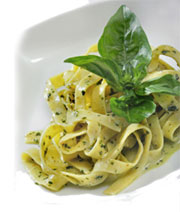 There was
a time when local choices for dried pasta were limited to
elbows, shells, flat noodles, or spaghetti. Their sauces were
limited to cheese, a white sauce, or tomato sauce
respectively. While there is nothing wrong with these
long-standing traditions, the options for other pasta dishes
are virtually limitless, and now, readily
accessible! There was
a time when local choices for dried pasta were limited to
elbows, shells, flat noodles, or spaghetti. Their sauces were
limited to cheese, a white sauce, or tomato sauce
respectively. While there is nothing wrong with these
long-standing traditions, the options for other pasta dishes
are virtually limitless, and now, readily
accessible!
Ingredients
Make the Pasta - Great pasta is made from hard wheat,
in particular, semolina flour. The inherent high-gluten,
high-protein qualities of semolina lend pasta many of its key
characteristics. Semolina has a 14% protein content compared
with bread flour that has a 12% protein complement. The higher
protein content allows the pasta to retain its shape better as
it is being formed. With less starch, the semolina-based pasta
absorbs less water which further adds to shape retention once
cooked. Pasta dough, in its most basic form, is semolina wheat
flour and water, with an egg or other liquid occasionally
substituted for the water. The pasta is kneaded, left to rest,
then formed into the desired shape. 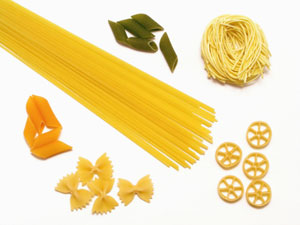 Commercially made pastas are dried
anywhere from 4 to 48 hours under low heat. The drying stops
any enzymatic activity and sets the stage for an indefinite
shelf life. Check the ingredients listing for "semolina flour"
before purchasing any packaged pasta. Experiment with
different brands of dried pasta - you'll be amazed at the
differences. Commercially made pastas are dried
anywhere from 4 to 48 hours under low heat. The drying stops
any enzymatic activity and sets the stage for an indefinite
shelf life. Check the ingredients listing for "semolina flour"
before purchasing any packaged pasta. Experiment with
different brands of dried pasta - you'll be amazed at the
differences.
Forming
Pasta Shapes - Ranging from anellini to ziti, there are
hundreds of pasta shapes to be had. Different pasta shapes
derive from centuries of tradition and the development of
regional Italian specialties. (Check out the illustrated
glossary of pasta shapes at the National Pasta Association's website). Flat
shapes are developed from pasta dough that has been carefully
rolled into sheets that become thinner with each subsequent
rolling. Round shapes such as spaghetti, capellini, and
spaghettini, are extruded by pressing the dough through a
plate with holes. Tube-shaped pastas such as bucatelli,
elbows, or penne, are also extruded in a similar
fashion. 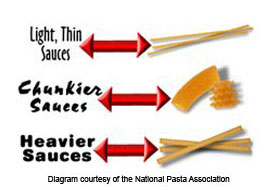 Brass extrusion plates will leave
a rougher surface on the pasta, (excellent for grabbing
sauces); as compared with non-stick plates that leave a
smooth, slightly glossy surface on the pasta. Brass extrusion plates will leave
a rougher surface on the pasta, (excellent for grabbing
sauces); as compared with non-stick plates that leave a
smooth, slightly glossy surface on the pasta.
Complement Shapes and Sauces
- A great pasta dish starts by choosing a shape and sauce that
complement each other. According to the National Pasta
Association, thin, delicate pastas should be paired with
light, thin sauces. Heavier sauces require a thicker
pasta shape. Chunky sauces prefer shapes with a 3-dimensional
character that provide a surface and gaps in the structure for
capturing the
sauce.
|
Cooking Perfect
Pasta
|
Dried or
fresh pasta hold equal stature on the quality and enjoyment
scale. The choice is guided by the desired dish and the whim
of the day. To cook perfect pasta follow a few key rules - the
results will reward you well!
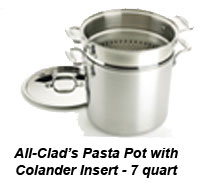 The Water - Use a large pot
with lots of water to cook pasta. More specifically, for
one pound of pasta use an 8 quart pot with 5-6 quarts of
water. Heat the water to a rolling boil. The large amount of
water achieves two goals: (1) a large mass of water will
return to boiling quickly and not be cooled by the added
pasta, and (2) a rolling boil keeps the water and the pasta
moving during cooking thus preventing sticking. The Water - Use a large pot
with lots of water to cook pasta. More specifically, for
one pound of pasta use an 8 quart pot with 5-6 quarts of
water. Heat the water to a rolling boil. The large amount of
water achieves two goals: (1) a large mass of water will
return to boiling quickly and not be cooled by the added
pasta, and (2) a rolling boil keeps the water and the pasta
moving during cooking thus preventing sticking.
The Salt - Salt the cooking
water generously. Traditionalists say "taste the water - it
should taste like the sea." If it's been some time since
you've tasted the sea, plan to use about 2 tablespoons of salt
for 6 quarts of water when making 1 pound of pasta. Most
experts will recommend using kosher salt, sea salt, or any
plain salt without additives, that is, without iodine or
anti-caking agents. The water may be salted before or after
boiling, just make sure it's there before the pasta is
added!
Measuring
Quantities of Pasta - The endlessly unique shapes of
pasta don't lend themselves to measuring cooking quantities by
volume. The best way to measure dry pasta is by weight; a
kitchen scale is invaluable in determining cooking quantities.
Nutritionally, a serving is defined as 2 ounces. We usually
plan on 4 ounces of pasta per person.
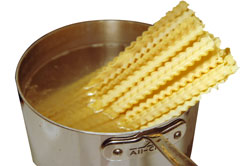 Cooking the Pasta - Add all
of the pasta at once to the boiling, salted water. Initially
stir the pasta in the water, then periodically as the pasta
cooks. This will keep the pasta from sticking together as the
surfaces become rehydrated. Use a lid on the pot to return the
water to a rolling boil, then leave the pot uncovered once the
boiling point has been achieved once again. Cooking the Pasta - Add all
of the pasta at once to the boiling, salted water. Initially
stir the pasta in the water, then periodically as the pasta
cooks. This will keep the pasta from sticking together as the
surfaces become rehydrated. Use a lid on the pot to return the
water to a rolling boil, then leave the pot uncovered once the
boiling point has been achieved once again.
The Timing - Fresh pasta is
cooked in 1-2 minutes. Cooking times for dried pasta will vary
according to their shape, quantity of water, boiling
temperature, and even by brand of pasta. The pasta's packaging
will often offer suggested cooking times. Use this as only a
sug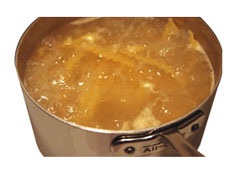 gestion. As you periodically stir
the pasta, check for doneness by removing a piece and biting
into it. You're probably familiar with the term "al dente"
which directly translated means "to the tooth." The cooked
pasta should be tender to the bite, yet firm. The al dente
point is achieved just when the pasta is done in its center,
not a minute longer. Pasta that's cooked too long will
be a mushy mess. gestion. As you periodically stir
the pasta, check for doneness by removing a piece and biting
into it. You're probably familiar with the term "al dente"
which directly translated means "to the tooth." The cooked
pasta should be tender to the bite, yet firm. The al dente
point is achieved just when the pasta is done in its center,
not a minute longer. Pasta that's cooked too long will
be a mushy mess.
The
Finishing - Reserve 1 cup of pasta water before
draining the pasta. Remove delicate pasta shapes with a
pasta spoon or a mesh skimmer. Drain sturdy pasta either by
lifting the cooking basket from the pot, or by pouring the
pot's contents into a colander. Don't rinse your pasta after
cooking unless it's destined for a cold salad. Unrinsed pasta
will retain more of its nutrients and allow the sauce to cling
better to its surfaces. Neither should you add oil to the
pasta at this point to keep it from sticking. Oiling will keep
the pasta from sticking to itself, but it will also keep the
sauce from adhering to the pasta. Add sauce to the cooked
pasta using the reserved cooking water, if necessary, to thin
it.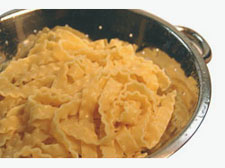
The Serving - Spring and
summer pastas may be served hot, warm, or cold - they're quite
accommodating! Pasta by nature is bland and craves strong
flavors. The cooler the temperature at which the pasta is to
be served, the stronger the sauce needs to be. Pasta may be
served family style or plated in pasta plates. Pasta
plates are large shallow bowls that organize the sauce
appropriately while providing easy access for the deployment
of the pasta spoon and a twirling
fork.
|
Pasta
Partners
|
There are
a few foods that always seem to show up when pasta appears on
the table! Through years of refinement, these pasta
partners are a classic part of the traditional and
contemporary experience.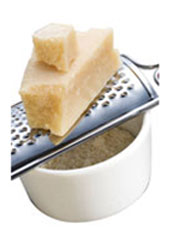
Cheese - A shower of grated
cheese atop a plate of pasta is the cue to pick up your fork
and begin eating. But first, back to the cheese. Hard cheeses
such as Parmigiano-Reggiano or an aged Pecorino Romano
complement many pasta dishes perfectly. Always keep a
chunk of one of these cheeses in your refrigerator, (they keep
very well), and grate it as needed. For grating, choose your
tool according to the desired outcome. There are some
great new tools for grating cheeses:
Graters -
with traditional cutting edges, graters come in different
sizes to produce the coarseness or fineness of shredded cheese
desired. A box grater has multiple sides each with its
own talent. We like some of the newer graters with
silicone-covered "feet" that protect the working surface.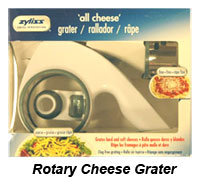
Rotary
graters - with this style of grater, a crank turns a
drum with cutting edges across a chunk of cheese. The
grated cheese falls from the inside of the drum directly on
the pasta entrée.
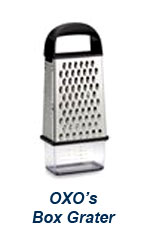 Planes -
It's hard to imagine life before Microplanes. As with other
grating tools, Microplanes come in a variety of grating
sizes. Microplanes are easy to handle and may be scraped
across the food, or the food scraped against the tool. They
are indispensable for not only cheese, but for zesting citrus
and so much more. Planes -
It's hard to imagine life before Microplanes. As with other
grating tools, Microplanes come in a variety of grating
sizes. Microplanes are easy to handle and may be scraped
across the food, or the food scraped against the tool. They
are indispensable for not only cheese, but for zesting citrus
and so much more.
Parmesan
Rasps - These tools are designed specifically for hard
cheese and result in a very fine
grate.
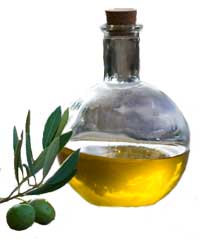 Olive Oil - Pasta demands
your best quality olive oil - it will show very well. Always
choose Extra Virgin Olive Oil for use in pasta sauces. The
fruitiness of the olive oil will blossom in the heat of the
pasta producing a delightful fragrance and rich taste. Olive Oil - Pasta demands
your best quality olive oil - it will show very well. Always
choose Extra Virgin Olive Oil for use in pasta sauces. The
fruitiness of the olive oil will blossom in the heat of the
pasta producing a delightful fragrance and rich taste.
Fresh Herbs -
Spring and summer offer fresh herbs in abundance. Start with
whichever herb is in season and develop your signature pasta
dish from there. Fresh herbs may be used generously; their
potency is much less than dried herbs. It's not too late to
plant some herbs for late summer enjoyment. Pick the herbs as
the water comes to a boil for ultimate
freshness. |
Cucina Fresca's Smart Pasta
Tips
|
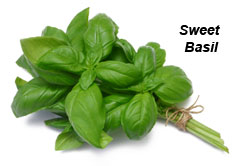 Tip #1: Add fresh herbs
to the pasta dish just after draining the pasta while it is
still hot. The heat will bloom the fragrant oils in the herbs
allowing their best side to appear. Tip #1: Add fresh herbs
to the pasta dish just after draining the pasta while it is
still hot. The heat will bloom the fragrant oils in the herbs
allowing their best side to appear.
Tip #2: For cold pasta
salads, avoid using butter in your recipes - stick with a high
quality olive oil. The chill will congeal the butter in
awkward places and produce a disconcerting appearance and
mouth feel. The olive oil will help keep the pasta from
sticking together even at the cooler
temperatures.
Tip
#3: Dried pastas should be stored in a dark
location. The vitamins that fortify the pasta are light
sensitive. Generally, boxed pasta may be stored indefinitely,
but plan to use within a year.
Tip #4: Include a bit
of fat and some protein in your pasta complements. This will
help balance the body's response to the pasta's carbohydrates
and moderate the blood-sugar levels.
Tip #5: In a hurry?
Choose a capellini or another thin-stranded pasta. It
cooks in one to two minutes and is ready for a light sauce.
Improvise the sauce with some great gourmet sauces. Some
choices perhaps originally intended for bruschetta or dips,
double as great pasta sauces.
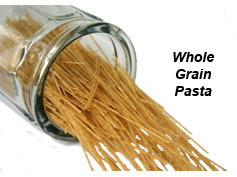
Tip #6: Have some fun
with a child this summer and renew the craft of macaroni
necklaces by using some of the fun, new, pasta shapes for
painting, dyeing, and stringing into a delightful "accessory"
or two.
Tip
#7: Manufactures of whole grain pastas have been
busy perfecting these healthy choices. If it's been a while
since you've tried whole grain pasta, it may be time to try it
again, they've
improved.
|
Summer Pasta
Recipes
|
Excerpted from Four
Seasons Pasta by Janet
Fletcher. Copyright 2004. Used with permission of Chronicle
Books, San Francisco, CA. All rights
reserved.
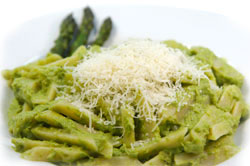 Penne with Creamy Sicilian Asparagus
Sauce Penne with Creamy Sicilian Asparagus
Sauce
This pasta and sauce took us by
surprise. It was deceptively simple to make and tasted like
some chef's exquisite creation. The bright spring green of the
sauce was a feast for the eyes as well as the palate. We
think there are additional possibilities for adapting this
sauce to whatever vegetables are bountiful at the
moment.
Click here to view the complete
recipe.
Click here for a
printable
version of the recipe.
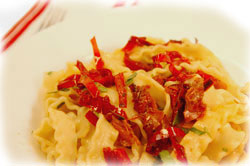 Dried Ribbon Pasta with Red Bell Peppers
and Prosciutto Dried Ribbon Pasta with Red Bell Peppers
and Prosciutto
Red bell peppers have a
sweetness in summer that surpasses their green or yellow
cousins. The red peppers sauté gently forming a rich medley
with the garlic and olive oil. A bit of prosciutto adds
savory richness. The dish comes together with long, ruffled
ribbons of mafaldine and flecks of fresh parsley. We were
hoping for leftovers, but there were none to be
had!
Click here to view the complete
recipe.
Click here for a
printable
version of the recipe.
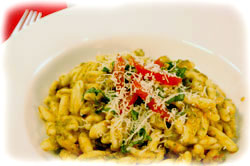 Pasta with a Pesto of Almonds, Tomatoes,
Capers, Anchovies, Garlic, and Salt Pasta with a Pesto of Almonds, Tomatoes,
Capers, Anchovies, Garlic, and Salt
This
riff on a traditional pesto produced surprisingly different
results. The sauce incorporates the classic flavors of basil
and garlic, then takes a different turn with red, ripe
tomatoes, almonds, a hint of mint, and some strong pecorino
cheese. There's nothing shy about this pesto! We think
you'll love it!
Click here to view the complete
recipe.
Click here for a
printable
version of the
recipe.
|
Bridal
Registry
|
Wedding
season in quickly approaching. Join us in celebrating the
engagements and pending nuptials for the following couples
registered at Cucina Fresca in 2009:
Jody
Gill & Dustin Allen
Wedding Date:
June 6, 2009
Andrea
Mori and Chad Sestanovich
Wedding
Date: June 20, 2009
Ruth Meyer and Tim
Feldman
Wedding
Date: June 27th 2009
Victoria Nalywaiks and
Nicholas Richardson
Shower
Date: June 5th, 2009
Wedding Date: July 4th,
2009
Korrie Vance
and Shaun Hornbarger
Wedding
Date: July 18th 2009
Carrie
Kelley and Joe Lostra
Wedding
Date: July 18, 2009
Holly
Gilbertson and Brett Hoffman-
Wedding Date: August 15th 2009 - (Wedding Registry List
is available online!)
| |
Enjoy the
summer pleasures that lie ahead! Buon
appetito!
|
|
| |